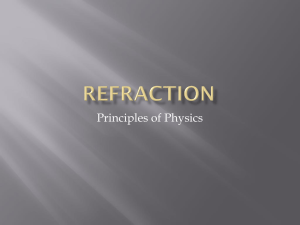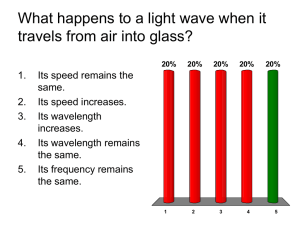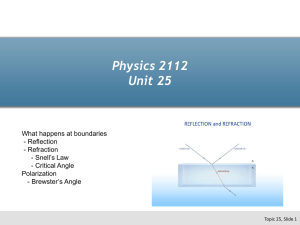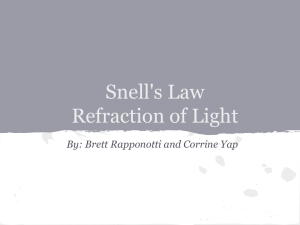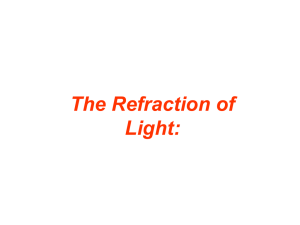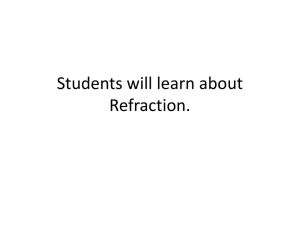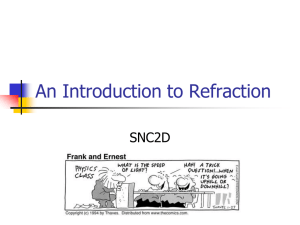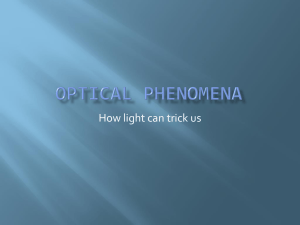File - Science & Math with Miss Kennedy
advertisement
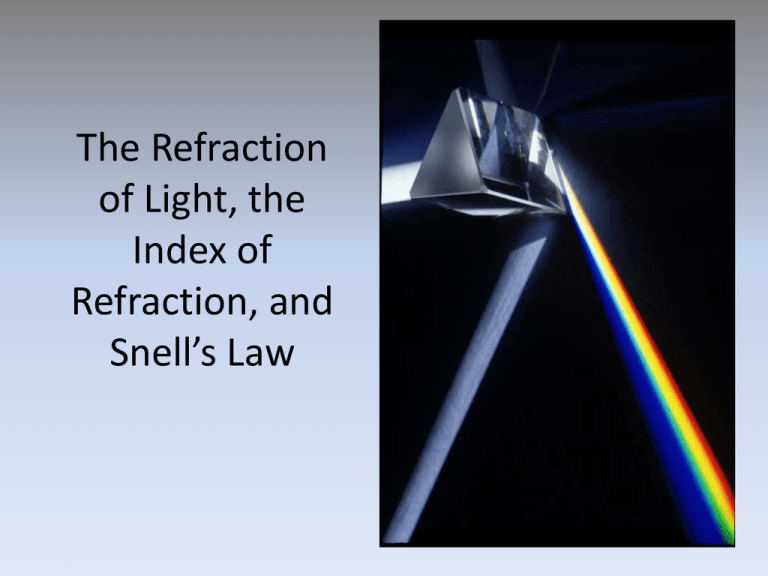
The Refraction of Light, the Index of Refraction, and Snell’s Law The bending or change in direction of light when it travels from one medium to another. Refraction is due to changes in the speed of light. Different media slow down light by different amounts. The more that light slows down the more the light is refracted. When light from the spoon passes from the water into the air the light rays are bent. 1) The incident ray, refracted ray & normal all lie in the same plane 2) When a ray of light passes into a slower, more optically dense medium, the ray of light bends towards the normal. (example air glass) 3) When a ray of light passes into a faster, less optically dense medium, the ray of light bends away from the normal. (example glass water) 4) When the angle of incidence is zero, there is no refraction. (No change in direction, yes a change in speed) 4 Rule #1: The incident ray, normal and refracted ray are all in the same plane. Rule #2: Light bends towards the normal when its speed decreases in a material. Medium 2 will have a slower speed of light Bends Towards the Normal 6 Rule #3: Light bends away from the normal when the speed increases material. Medium 2 will have a greater speed of light Bends away from the Normal 7 Rule #4: When the angle of incidence is zero, there is no refraction. (No change in direction, yes a change in speed) 8 Recall: The Index of Refraction • The refractive index of a medium is determined by comparing the speed of light in the medium with the speed of light in a vacuum Index of refraction of material = speed of light in vacuum speed of light in medium Where: • n is the index of refraction • c is the speed of light (vacuum) (always 3.00x108 m/s) • v is the speed of light in a given medium. The index of refraction has no units because both m/s speeds cancel out. The speed of light in glass is 1.52 x 108 m/s. What is the Index of Refraction for glass?? Given: c = 3.00 x 108 m/s v = 1.52 x 108 m/s n=? n = 3.00 x 108 m/s 1.52 x 108 m/s n = 1.96 Therefore, the index of refraction of glass is 1.96. Snell’s Law • A formula that uses values for the index of refraction to calculate the new angle that a ray will take as a beam of light strikes the interface between two media. 11 Snell’s Law • If you call the indices of refraction of the two media n1 and n2 and call the angles of incidence and the angle of refraction θ1 and θ2 then the formula for Snell’s law is: n1sinθ1 = n2sinθ2 12 Getting a value for sin using your Calculator • Different calculators may require different inputs for calculating sin • Option 1 (for most): – Press sin then the number corresponding to the angle (i.e. for sin 30° you would type sin then 30) • Option 2: – Other calculators will require you to type the number first then punch in sin (i.e. for sin 30° you would type 30 then sin) 13 Calculating an Unknown Angle • When using Snell’s law, you may end up in a situation where you are looking for the angle only: 0.65 = sinθwater • In such a case, you will have to isolate the angle from the sin symbol in front of it. • To do this you will have to move the sin over to the other side of the equation where it will become sin -1 or the inverse of sin • To calculate this, on most calculators, you will need to press second function and then the sin symbol (look for sin -1) • As for finding sin, depending on your calculator you may have to press sin -1 1st or you may need to punch in the angle first. 14 Example 1 • In an experiment, a block of cubic zirconia is placed in water. A laser beam is passed from the water through the cubic zirconia. The angle of incidence is 50o, and the angle of refraction is 27o. What is the index of refraction of cubic zirconia? • Given: – nwater = 1.33 – Θwater= 50o – Θzirc= 27o • Required: Analysis: n1sinθ1 = n2sinθ2 nwatersinθwater = nzircsinθzirc – nzirc= ? 15 Example 1 • Solve: Paraphrase: nwatersinθwater = nzircsinθzirc 1.33 X Sin 50 = nzirc sin 27° nzirc = 1.33 X sin 50 sin 27° nzirc = 1.33 X 0.76 0.45 nzirc = 2.25 The index of refraction for cubic zirconia is 2.25 16 Example 2 • When light passes from air into water at an angle of 60o from the normal, what is the angle of refraction? • Given: – nair= 1.0003 – nwater = 1.33 – Θair = 60o • Required: Analysis: n1sinθ1 = n2sinθ2 nairsinθair = nwatersinθwater – Θwater = ? 17 • Solve: Example 2 nairsinθair = nwatersinθwater 1.0003 X sin60° = 1.33 sinθwater 1.0003 X 0.87 = 1.33 sinθwater 0.87 = 1.33 sinθwater 0.87 = sinθwater 1.33 0.65 = sinθwater sin-1 0.65 = θwater θwater = 40.5° Paraphrase: The angle of refraction is 40.5 ° 18 Now… • 1) Answer Snell’s Law Problems on worksheet • 2) Determine the unknown substance! • 3) Hand in at end of class
